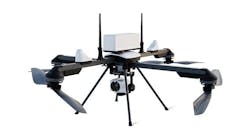Aerial Production Services (APS) Teams with Iris Automation to Jumpstart FAA Permissions for Pipeline Inspections with Drones
Crofton, Maryland, San Francisco, Calif. (March 17, 2021) – Helping a client switch from expensive satellite and airplane-based inspections to drones, service provider Aerial Production Services (APS) was able to improve inspection frequency by 350% and dramatically reduce costs. These efficiencies were enabled by a Federal Aviation Administration (FAA) waiver for beyond line of sight (BVLOS) flights, achieved by enlisting regulatory professional services from Iris Automation, who cut the time taken to receive approval by an estimated six months.
APS, a drone service provider for telecommunications, natural gas and oil, and construction industries, aims to provide the safest, most innovative and precise solutions for aerial inspections of pipelines, cellular and utility towers. The company has flown over 17,000 sites in 49 states, leveraging pilots with specialized expertise flying specific, sensitive assets. However, commercial drone operations are limited by VLOS (Visual Line of Sight) rules, which severely restrict the distances they can cover.
APS’s BVLOS waiver application was built using Iris Automation’s Regulatory Resource Center (RRC), creating a robust risk assessment, mitigation and CONOP package for BVLOS flights for the safest flight operations program possible. The RRC provides a structured workflow to help address regulatory and safety concerns that the Civil Aviation Authority (CAA) require, with an online portal to build, test, and audit complex and advanced operational approvals supported by a team of UAS regulatory experts.
Quote from Dave Sotiros, CEO of Aerial Production Services
“While we had the foundational knowledge of how to obtain the BVLOS waiver, we lacked the expertise to properly convey our operation to the FAA. With Iris Automation’s support and knowledge of BVLOS, they took the time to understand our goals and helped us identify areas of improvement and potential gaps in our processes. This guidance allowed us to aggressively pursue the BVLOS waiver and implement a BVLOS program that mirrors the focus of APS’s principles: Safer, Faster, Better.”
The waiver granted to APS allows for point-to-point pipeline inspections using Visual Observers (VOs) and a DJI Matrice aircraft for an area outside of Manning, North Dakota covering over six square miles. APS can now report leaks in four days instead of the four weeks it was before, while using just a two-person crew covering three times the distance previously possible. This in turn has increased the frequency of inspections.
Quote from Trever Linn, Director of Airspace Integration at Iris Automation
“Accelerating the timeline and reducing the complexity of the waiver process provides a critical business advantage for service providers like APS, allowing them to scale their operations while actually reducing costs and maintaining the highest level of safety. As critical detect and avoid (DAA) technology, standards, and regulations evolve we’ll see true implementation of advanced unpiloted operations that will use waivers like this to inform equipment, training, and operational requirements within a new regulatory framework. The business opportunity to be an early adopter of this capability is immense, and the RRC provides a framework to do so.”
Quote from Drew Talley, Managing Pilot, Oil & Gas Team, Aerial Production Services
“Achieving our BVLOS waiver is critical to serving our customers in the oil and gas sector. To be able to serve our customers efficiently on long linear infrastructure makes achieving and pioneering BVLOS key. BVLOS efficiency allows APS to reduce our costs and pass these savings to our customers.”
Iris Automation participates in the Federal Aviation Administration’s BEYOND program to advance complex beyond line of sight UAS operations in the US National Airspace System. Iris Automation is committed to developing critical detection technologies and working closely with global policymakers and regulators to develop appropriate BVLOS safety standards. Ultimately for commercial drone use to become widespread, clear standards for incorporating onboard detect-and-avoid (DAA) capabilities will be necessary to ensure a high degree of air safety.

